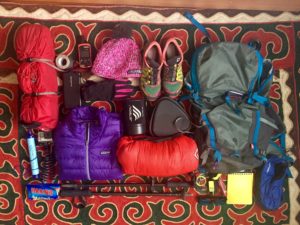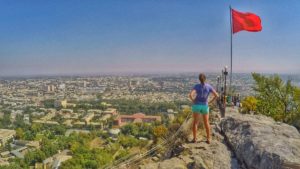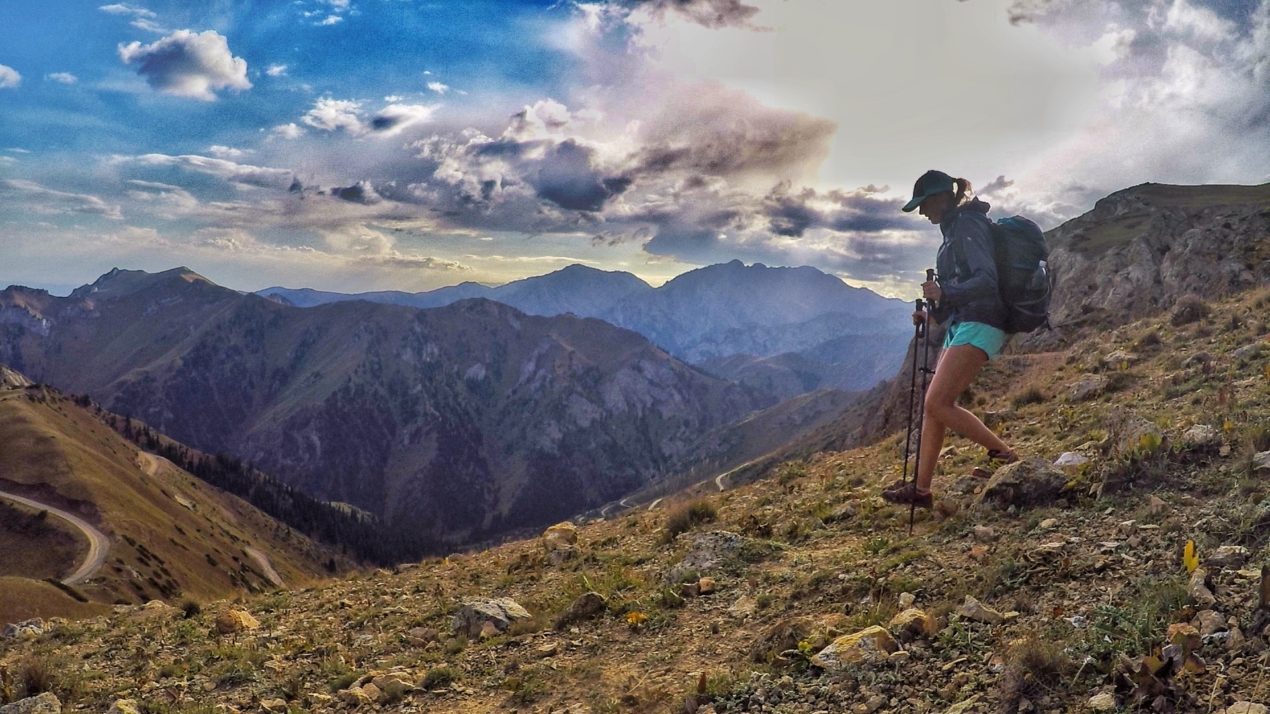Through the Path of the Mountains: Q & A with Runner Jenny Tough
Jenny Tough has many incredible outdoor accomplishments under her belt and is currently trying to run across a mountain range in every continent. What does it take to go after such lofty goals? We asked Jenny about her fall 2016 journey to become the first solo person to complete a nearly 1000km, unsupported run through unmapped terrain across the Tian Shan mountains of Kyrgyzstan. We wanted to learn what makes her take on these massive goals and what it’s like to give your all in an incredibly wild place.
Growing up, did you always know you were going become an adventurer?
Absolutely not! I thought I would go to university and that would lead to a “real job” and that would be that. Not very exciting, but it was what I had always been told life was about. Travel and the outdoors were always my biggest passions, but I thought they would just be something that I would squeeze in on the sides. I never knew that I would end up needing to do big adventures like this – I didn’t even know such a world existed
You were the first person to run solo and unsupported across the Tian Shen Mountains in Kyrgyzstan. What was it about the challenge that enticed you in the first place?
I grew up in the Canadian Rockies, and mountains have always felt like home for me. My desire to go to the Tian Shan was born from a need to explore mountains, and during my research of this mysterious mountain range I somehow came up with the idea that I would cover the whole thing on my own two feet. I’ve been a runner for a long time, looking for bigger challenges every year, and I began to wonder just how far it was possible to run. This seemed like a great way to find out.

How do you physically and mentally prepare for an expedition like this? Can you truly prepare for something like what you experienced?
I think being quite experienced in endurance sport helped the most – the hardest thing, mentally, about endurance is the long, slogging hours on your own. Being quite good at handling that helped a lot. I’m also quite experienced in traveling off the beaten path, so while I had no idea what Kyrgyzstan or Central Asia would be like, I at least already knew that I could adapt to a strange environment.
Experience helps, but it’s really impossible to be completely prepared. Besides, it’s not an adventure unless it’s outside of your comfort zone.
Was a solo expedition through an unfamiliar environment something you were ever discouraged against because of your gender? Do you think it affected how you were treated whilst out there?
Constantly. The funny thing is, though, because everyone I met perceived what I was doing to be far more dangerous because I was a woman meant that everyone was overwhelmingly hospitable and even protective towards me. There is a global perception that the world is a dangerous place for a woman, and because of that, the global community actually compensates by being very friendly towards a woman. In every village I stayed in, people went out of their way to make me feel safe and welcome.
You’re an incredibly driven person, so to read about how close you were to quitting throughout the journey really hits home. How did you keep yourself going?
There’s an old adage that says, “when you think about quitting, remind yourself why you started”. I went to Kyrgyzstan to have a real adventure and to push the limits of what I was capable of. The breakdowns along the way were like validations that I was truly pushing myself hard. And when that motivation fails, there was always the reality that if I didn’t keep going, I would be stuck out in the mountains and would never get home. You have to keep moving!
How much did you have to improvise when it came to your route? Was it a case of having a plan for each day of the expedition? Or just taking it day-by-day?
Because no maps of the interior existed, the route that I had plotted in my GPS was really just a hopeful guess created through endless zooming on satellite images. I had no idea if my routes would work out, and many times they didn’t. I could often find nomads to give me advice, but they would usually only know their small territory, so it really was a case of planning day to day and being really flexible. My original ‘route’ that I plotted in my GPS did not match very closely to the track that I did in reality!
It’s fair to say you went through a lot during your time there. What were the toughest moments? Do you ever look back and wonder how you managed it?
I still can’t believe I got away with it… So many difficult moments and situations unfolded, and I really don’t know how I managed. I started the adventure by succumbing to altitude sickness that plagued me for nearly a week (and resulted in a host of poor decision-making), got lost on several occasions, ran out of water on even more occasions, had a pretty severe near-death experience, and got bad food poisoning at the very end which took me days to recover from. Things got pretty real out there!
In contrast to the lows, what were the highlights? Can you look back and enjoy these more now?
I had highlights every day that I’ll never forget. I enjoyed perfect mountain sunsets, stunning alpine lakes, and enjoyed true alpine wilderness – my favourite natural environment. But my highlight has to be the time I spent with the Kyrgyz nomads – they showed me so much incredible kindness and hospitality along the way and taught me a lot about mountain culture.

How did you celebrate finishing the run?
I told myself that I would celebrate – I’m pretty sure I looked forward to a nice hotel and a big pizza the whole 23 days – but when I got there, it was kind of anti-climactic. I had been running for so long that it was just part of who I was, and when I got up the first morning after finishing I didn’t really know what to do with myself, and I really missed my tent and the mountains. The truth is, I still haven’t really celebrated what was to this day one of my favourite achievements.
What inspires and motivates you to continue taking up new challenges? Do you have any upcoming?
One thing I’m learning is that we are all capable of more than we think. When I decided to run across Kyrgyzstan, I truly didn’t know if it was possible and I was insanely terrified of how great the challenge was ahead of me. But, I achieved it, so knew I had to try something harder. Since running across the Tian Shan, I decided to run across a mountain range on every continent, and I’m specifically picking mountains where remote mountain communities still exist, much like the experience I had with the Kyrgyz nomads. In 2017, I ran across the Atlas Mountains where the Berbers were my hosts, and this year I’m going to run across the Sierra Occidental of Bolivia/Chile where the Quechua live.
What advice would you give to people inspired by your path and the adventures you’ve embarked on?
Go for it. You have to go for it! If you are dreaming of an adventure, it’s important to you, and you need to make it happen. If it doesn’t seem possible, make a list of all of the things that stand in between you and your big adventure. Perhaps it’s your job, health, money, skills, etc. Make a list and figure out how you can change all of those things, so you can make your adventure happen. Trust me, you’re capable of so much more than you think.
Jenny wrote about her Tian Shan journey on her website and shared her “Mountains of Heaven” documentary about the trip. Also, check out her piece “The Path of the Mountains” in Discover Interesting.
To learn more about Jenny and her latest adventures visit her website, Instagram, YouTube, and Twitter.

